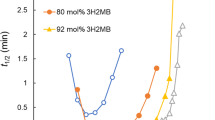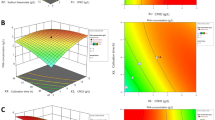Abstract
Two polyhydroxyalkanoate (PHA) copolymers, poly(3-hydroxybutyrate-co-3-hydroxy-3-phenylpropioate) [P(3HB-co-3H3PhP)] and poly(3-hydroxybutyrate-co-3-hydroxy-4-phenylbutyrate) [P(3HB-co-3H4PhB)], both bearing aromatic side chains, were biosynthesized by recombinant Ralstonia eutropha fed with a respective precursor for the aromatic unit. As bacterial PHA copolymers generally exhibit broad comonomer compositional distribution, the as-biosynthesized samples, P(3HB-co-18 mol% 3H3PhP) and P(3HB-co-11 mol% 3H4PhB), were fractionated into several fractions with narrow comonomer compositional distribution using a chloroform/n-hexane mixed solvent. When the fractionated samples were aged under ambient conditions, the P(3HB-co-3H3PhP) fraction with 12 mol% 3H3PhP exhibited a melting temperature (Tm) of 132–148 °C, whereas the fractions with 15–21 mol% 3H3PhP did not exhibit melting behavior. As for P(3HB-co-3H4PhB), all fractions with a range of 4–15 mol% 3H4PhB exhibited Tm in the range 105–151 °C. The glass transition temperature (Tg) of these copolymers increased with increasing aromatic unit content, and the highest Tg of 20 °C was observed for the fraction with 21 mol% 3H3PhP. On the basis of the results presented here, the effects of aromatic comonomers on the thermal properties of the resulting copolymers are discussed.
Similar content being viewed by others
Log in or create a free account to read this content
Gain free access to this article, as well as selected content from this journal and more on nature.com
or
References
Sudesh, K., Abe, H. & Doi, Y. Synthesis, structure and properties of polyhydroxyalkanoates: biological polyesters. Prog. Polym. Sci. 25, 1503–1555 (2000).
Tsuge, T. Fundamental factors determining the molecular weight of polyhydroxyalkanoate during biosynthesis. Polym. J. 48, 1051–1057 (2016).
Tsuge, T. Metabolic improvements and use of inexpensive carbon sources in microbial production of polyhydroxyalkanoates. J. Biosci. Bioeng. 94, 579–584 (2002).
Noda, I., Green, P. R., Satkowski, M. M. & Schechtman, L. A. Preparation and properties of a novel class of polyhydroxyalkanoate copolymers. Biomacromolecules 6, 580–586 (2006).
Tanadchangsaeng, N., Kitagawa, A., Yamamoto, T., Abe, H. & Tsuge, T. Identification, biosynthesis, and characterization of polyhydroxyalkanoate copolymer consisting of 3-hydroxybutyrate and 3-hydroxy-4-methylvalerate. Biomacromolecules 10, 2866–2874 (2009).
Mizuno, S., Katsumata, S., Hiroe, A. & Tsuge, T. Biosynthesis and thermal characterization of polyhydroxyalkanoates bearing phenyl and phenylalkyl side groups. Polym. Degrad. Stab. 109, 379–384 (2014).
Feng, L., Yoshie, N., Asakawa, N. & Inoue, Y. Comonomer-unit compositions, physical properties and biodegradability of bacterial copolyhydroxyalkanoates. Macromol. Biosci. 4, 186–198 (2004).
Yoshie, N., Menju, H., Sato, H. & Inoue, Y. Complex composition distribution of poly(3-hydroxybutyrate-co-3-hydroxyvalerate). Macromolecules 28, 6516–6521 (1995).
Yamada, S., Wang, Y., Asakawa, N., Yoshie, N. & Inoue, Y. Crystalline structural change of bacterial poly(3-hydroxybutyrate-co-3-hydroxyvalerate) with narrow compositional distribution. Macromolecules 34, 4659–4661 (2001).
Watanabe, T., He, Y., Fukuchi, T. & Inoue, Y. Comonomer compositional distribution and thermal characteristics of bacterially synthesized poly(3-hydroxybutyrate-co-3-hydroxyhexanoate)s. Macromol. Biosci. 1, 75–83 (2001).
Feng, L., Watanabe, T., Wang, Y., Kichise, T., Fukuchi, T., Chen, G. Q., Doi, Y. & Inoue, Y. Studies on comonomer compositional distribution of bacterial poly(3-hydroxybutyrate-co-3-hydroxyhexanoate)s and thermal characteristics of their factions. Biomacromolecules 3, 1071–1077 (2002).
Tanadchangsaeng, N., Tsuge, T. & Abe, H. Comonomer compositional distribution, physical properties, and enzymatic degradability of bacterial poly(3-hydroxybutyrate-co-3-hydroxy-4-methylvalerate) copolyesters. Biomacromolecules 11, 1615–1622 (2010).
Raberg, M., Voigt, B., Hecker, M. & Steinbüchel, A. A closer look on the polyhydroxybutyrate-(PHB- negative phenotype of Ralstonia eutropha PHB-4. PLoS ONE 9, e95907 (2014).
Saika, A., Ushimaru, K., Mizuno, S. & Tsuge, T. Genome-based analysis and gene dosage studies provide new insight into 3-hydroxy-4-methylvalerate biosynthesis in Ralstonia eutropha. J. Bacteriol. 197, 1350–1359 (2015).
Takase, K., Taguchi, S. & Doi, Y. Enhanced synthesis of poly(3-hydroxybutyrate) in recombinant Escherichia coli by means of error-prone PCR mutagenesis, saturation mutagenesis, and in vitro recombination of the type II polyhydroxyalkanoate synthase gene. J. Biochem. 133, 139–145 (2003).
Takase, K., Matsumoto, K., Taguchi, S. & Doi, Y. Alteration of substrate chain-length specificity of type II synthase for polyhydroxyalkanoate biosynthesis by in vitro evolution: in vivo and in vitro enzyme assays. Biomacromolecules 5, 480–485 (2004).
Kovach, M. E., Elzer, P. H., Hill, D. S., Robertson, G. T., Farris, M. A., Roop, R. M. & Peterson, K. M. Four new derivatives of the broad-host-range cloning vector pBBR1MCS, carrying different antibiotic-resistance cassettes. Gene 166, 175–176 (1995).
Kawashima, Y., Cheng, W., Mifune, J., Orita, I., Nakamura, S. & Fukui, T. Characterization and functional analyses of R-specific enoyl coenzyme A hydratases in polyhydroxyalkanoate-producing Ralstonia eutropha. Appl. Environ. Microbiol. 78, 493–502 (2012).
Kato, M., Bao, H. J., Kang, C. K., Fukui, T. & Doi, Y. Production of a novel copolyester of 3-hydroxybutyric acid and medium-chain-length 3-hydroxyalkanoic acids by Pseudomonas sp. 61-3 from sugars. Appl. Microbiol. Biotechnol. 45, 363–370 (1996).
Watanabe, Y., Ichinomiya, Y., Shimada, D., Saika, A., Abe, H., Taguchi, S. & Tsuge, T. Development and validation of an HPLC-based screening method to acquire polyhydroxyalkanoate synthase mutants with altered substrate specificity. J. Biosci. Bioeng. 113, 286–292 (2012).
Matsusaki, H., Abe, H. & Doi, Y. Biosynthesis and properties of poly(3-hydroxybutyrate-co-3-hydroxyalkanoates) by recombinant strains of Pseudomonas sp. 61-3. Biomacromolecules 1, 17–22 (2000).
Sato, S., Nomura, C. T., Abe, H., Doi, Y. & Tsuge, T. Poly[(R-3-hydroxybutyrate] formation in Escherichia coli from glucose through an enoyl-CoA hydratase-mediated pathway. J. Biosci. Bioeng. 103, 38–44 (2007).
Tomizawa, S., Sato, S., Lan, J. C. W., Nakamura, Y., Abe, H. & Tsuge, T. In vitro evidence of chain transfer to tetraethylene glycols in enzymatic polymerization of polyhydroxyalkanoate. Appl. Microbiol. Biotechnol. 97, 4821–4829 (2013).
Thomson, N. M., Sangiambut, S., Ushimaru, K., Sivaniah, E. & Tsuge, T. Poly(hydroxyalkanoate) generation from nonchiral substrates using multiple enzyme immobilizations on peptide nanofibers. ACS Biomater. Sci. Eng. (2017). (in press). doi:10.1021/acsbiomaterials.6b00329
Tsuge, T., Taguchi, K., Taguchi, S. & Doi, Y. Molecular characterization and properties of (R-specific enoyl-CoA hydratases from Pseudomonas aeruginosa: metabolic tools for synthesis of polyhydroxyalkanoates via fatty acid β-oxidation. Int. J. Biol. Macromol. 31, 195–205 (2003).
Kamiya, N., Yamamoto, Y., Inoue, Y., Chujo, R. & Doi, Y. Microstructure of bacterially synthesized poly(3-hydroxybutyrate-co-3-hydroxyvalerate). Macromolecules 22, 1676–1682 (1989).
Fox, T. G. Influence of diluent and of copolymer composition on the glass temperature of a polymer system. Bull. Am. Phys. Soc. 1, 123–135 (1956).
Fox, T. G. & Flory, P. J. Second-order transition temperatures and related properties of polystyrene. I. Influence of molecular weight. J. Appl. Phys. 21, 581–591 (1950).
Fritzsche, K., Lenz, R. W. & Fuller, R. C. An unusual bacterial polyester with a phenyl pendant group. Macromol. Chem. 191, 1957–1965 (1990).
Ward, P. G. & O’Connor, K. E. Bacterial synthesis of polyhydroxyalkanoates containing aromatic and aliphatic monomers by Pseudomonas putida CA-3. Int. J. Biol. Macromol. 35, 127–133 (2005).
Song, J., Choi, M., Yoon, S. & Huh, N. Cometabolism of ω-phenylalkanoic acids with butyric acid for efficient production of aromatic polyesters in Pseudomonas putida BMOl. J. Microbiol. Biotechnol. 11, 435–442 (2001).
Abraham, G. A., Gallardo, A., San Roman, J., Olivera, E. R., Jodra, R., García, B., Miñambres, B., García, J. L. & Luengo, J. M. Microbial synthesis of poly(β-hydroxyalkanoates) bearing phenyl groups from Pseudomonas putida: chemical structure and characterization. Biomacromolecules 2, 562–567 (2001).
Shen, R., Cai, L., Meng, D., Wu, L., Guo, K., Dong, G., Liu, L., Chen, J. C., Wu, Q. & Chen, G. Q. Benzene containing polyhydroxyalkanoates homo-and copolymers synthesized by genome edited Pseudomonas entomophila. Sci. China Life Sci. 57, 4–10 (2014).
Acknowledgements
This work was supported by a Grant-in-Aid for Scientific Research (KAKENHI 23658271) and partially supported by JST, CREST.
Author information
Authors and Affiliations
Corresponding author
Ethics declarations
Competing interests
The authors declare no conflict of interest.
Rights and permissions
About this article
Cite this article
Mizuno, S., Hiroe, A., Fukui, T. et al. Fractionation and thermal characteristics of biosynthesized polyhydoxyalkanoates bearing aromatic groups as side chains. Polym J 49, 557–565 (2017). https://doi.org/10.1038/pj.2017.20
Received:
Revised:
Accepted:
Published:
Issue date:
DOI: https://doi.org/10.1038/pj.2017.20
This article is cited by
-
Toward the production of block copolymers in microbial cells: achievements and perspectives
Applied Microbiology and Biotechnology (2024)
-
Biogeochemical properties of blue carbon sediments influence the distribution and monomer composition of bacterial polyhydroxyalkanoates (PHA)
Biogeochemistry (2023)
-
Biopolymer production in microbiology by application of metabolic engineering
Polymer Bulletin (2022)
-
Thermal properties of poly(3-hydroxy-2-methylbutyrate-co-3-hydroxybutyrate) copolymers with narrow comonomer-unit compositional distributions
Polymer Journal (2021)
-
Established and Emerging Producers of PHA: Redefining the Possibility
Applied Biochemistry and Biotechnology (2021)



